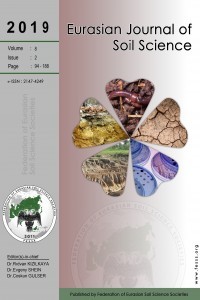
Eurasian Journal of Soil Science
Yazarlar: Maira KUSSAİNOVA, Konstantin PACHİKİN, Olga EROKHİNA
Konular:Fen
DOI:10.18393/ejss.286636
Anahtar Kelimeler:Soil degradation,Kazakhstan,Zhetysu Ridge,Geoinformation technologies,Types of degradation
Özet: Identification of land degradation is essential to check the problem and to implement the remedial measures needed. The study area falls under parts of foothill plains Zhetysu Ridge, Kazakhstan, that is an arid region in climate. Recent data on the status of study area refer to the 80s of the last century, and the intensive use of them led to a significant anthropogenic transformation. This study was carried out in 2015-2016 as part of a project aimed to study features and causes of land degradation in foothill plains Zhetysu Ridge, Kazakhstan. Under the conditions of rainfed soil degradation manifests itself in the development of erosion processes, agro depletion of soils, reducing the productivity of agriculture. The use of land for irrigation often accompanied by secondary salinization. In this regard, at present there is need to assess current state of the soil, with the identification of changes in their properties as a result of the impact of various anthropogenic factors and creation of new electronic soil maps and applied the powerful capabilities of advanced remote sensing (RS) and geographic information system (GIS) techniques to identify the geomorphological units and degradation risk assessment. Satellite imagery in addition to the field and laboratory studies to identify salinity-induced soil degradation was adopted in this study. Morphological, chemical and physical characteristics of soils in degraded sites in foothill plains Zhetysu Ridge, Kazakhstan, were depicted. The main results of a thorough evaluation of soil degradation in foothill plains Zhetysu Ridge, Kazakhstan, are presented. The data revealed that extent of salinity-induced degradation was generally related to some physical properties of soil, uncontrolled livestock grazing and previous soil management practices. These results are useful as the basis for designing soil conservation and restoration programs, as a base line for evaluating the performance of conservation programs and for assessing the impact of other soil-related activities (e.g. agriculture and livestock rising).